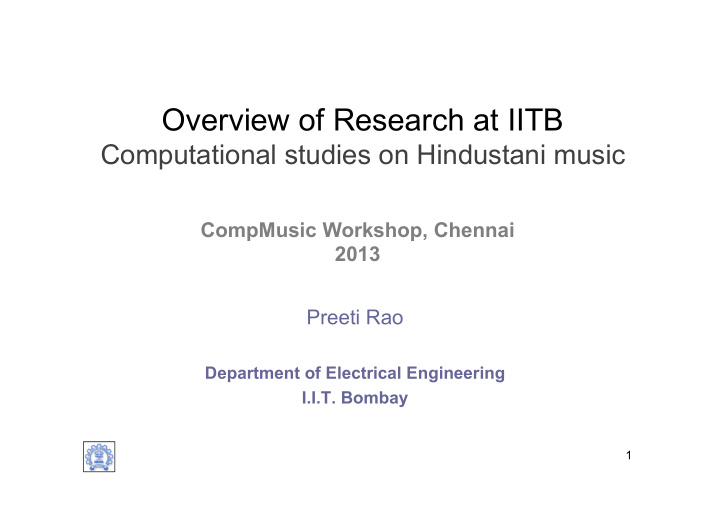



Overview of Research at IITB Computational studies on Hindustani music CompMusic Workshop, Chennai 2013 Preeti Rao Department of Electrical Engineering I.I.T. Bombay 1
Some goals • Automatic “tagging” of audio by genre, style, raga, tala and other discovered descriptors and relationships • Automatic creation of “navigation layer” for concert audio • Facilitating search for musically relevant objects such as melodic and rhythmic motifs • Building tools that facilitate musicological research on performance practices Common to all the above: Need for a music representation (aka features) and similarity measure (for classification) 2
Music CD cover information … (YouTube has even less!) 3
Hindustani music descriptors/tags • Artiste (instrument), accompanists • Genre (dhrupad, khyal, tarana … ), sub-genre (gharana) • Concert structure and sections with timing – Bada khyal, Chhota khyal • Bandish: alap, vistaar, taan • Raga, Tala, Laya of major sections • Composition (bandish, identified by mukhda) The question Can the descriptions be obtained by audio content analysis and possibly enhanced with contextual semantic information ? 4
Kishori Amonkar Deshkar: bada khyal (vistaar, taan) Alap (slow tempo) Alap (medium tempo) Taan 5
Kishori Amonkar Deshkar: bada khyal taan, chhota khyal taan Taan (madhylaya) Taan (drut laya) 6
Kishori Amonkar Deshkar vistaar taan chhota khyal alap (bada khyal) (bada khyal) 7
Uday Bhawalkar (dhrupad) Yaman Alap Jod (alap) Jhala (alap) 8
Uday Bhawalkar (dhrupad) Yaman alap jod jhala 9
Kishori Amonkar: Deshkar, Gaud-Sarang Raga Deshkar Raga Gaud Sarang 10
original resynthesized Raga Deshkar Raga Gaud Sarang 11
Raga Deshkar P P P P G G G G G G R S R R S R S R S S R S S D Raga Gaud Sarang G S R S D S S R R S S S D S D D D 12
Raga characteristics from pitch distribution Pt. Vidhyadhar Vyas Marwa and Puriya (share the same swaras) 13
Melodic motif ( mukhda ) detection Kishori Amonkar, Deshkar, Tintal 14 Bandish: Piya Jaag
Phrase duration, dependence on tempo 15
Within-concert variability of motif 16
Within-concert variability across concerts Intra-phrase class distance distribution Kafi 17
Ontology for Indian music Learning metadata (textual) from forums by using NLP techniques to learn relationships between entities. • Augment audio-based music ontology for Indian music with information extracted from online music forums to achieve superior retrieval systems for Indian music. Example: Get songs with phrase ‘NDNP’ and sung by a disciple of D.K. Pattammal • Challenges: text sources are unstructured, ungrammatical … 18
Summary • High-level musical attributes (melody, rhythm) can be derived from low-level acoustic parameters such as pitch and onsets extracted by audio signal processing. • The audio signal processing is challenging due to the mixture of several instruments, strong diversity in the characteristics and the highly time-varying nature. • Melody and rhythm representations that are musicologically informed can be useful in the description of music recordings. • Knowledge can be very helpful. Creating these from available sources is a challenge. 19
Coming up … • Vedhas Pandit, Kaustuv : Characterization of melodic motifs • Vinutha T. P.: Rhythmic structure based segmentation • Joe Cheri Ross: Ontology for Indian Music: An Approach for ontology learning from online music forums • Amruta J. Vidwans and Prateek Verma: Melodic style detection in Hindustani music 20
Thank you 21 Department of Electrical Engineering , IIT Bombay
Recommend
More recommend